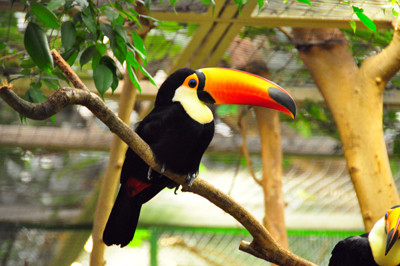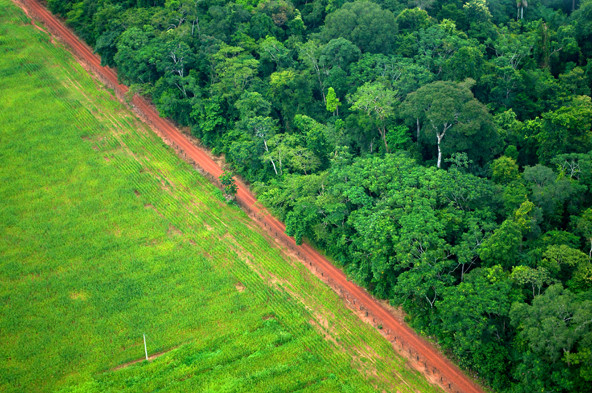 The toco toucan is the largest species in the toucan family and inhabits many regions of South America. (Photo by Olaf Oliviero Riemer)
The toco toucan is the largest species in the toucan family and inhabits many regions of South America. (Photo by Olaf Oliviero Riemer)
Visiting Brazil’s Atlantic forest last August—the second-most diverse ecosystem on the planet after the Amazon—I saw the impact of deforestation firsthand. In a habitat where 85 percent of the original forest has been cleared, a toucan stood out in the foliage due to its golden, oversized beak. This iconic bird is unusual not only because of its appearance, but also because it is well adapted to deforestation, preferring open land to dense jungle.
Most plants and animals unfortunately do not have the same evolutionary advantage. The current rate of extinction across the planet is 1,000 times higher than the natural rate. The world is losing 150-200 species daily; in the time it takes you to read this, we will have lost one more.
Conventional biodiversity arguments make the case for saving great beasts such as elephants and tigers because they inspire awe and contribute to healthy ecosystems. Biodiverse environments have better soil health, more stable climates, and greater resilience against natural disasters such as floods.
But a growing body of scientific evidence and real-life examples points to yet another benefit: substantial economic value. In fact, biodiversity is critical to the sustainability of businesses around the world. If the biodiversity crisis continues unabated, for example, the food, commercial forestry, and ecotourism industries stand to lose a collective $338 billion a year.
Are you enjoying this article? Read more like this, plus SSIR's full archive of content, when you subscribe.
Biodiversity’s economic value starts at the dinner table. Fresh produce, in addition to being a vital part of our diet, yields $61 billion in annual sales. Without honeybees, this figure would be much lower. The hard-working pollinator is responsible for one of every three bites of we eat in the United States: We rely on honeybees to pollinate apples, oranges, almonds, and around a hundred other foods. But between 2015-16, 44 percent of honeybee colonies died. This raised prices for American-grown nuts, fruits, and vegetables. Our food supply shows that ecosystems are complex and interconnected; changes at one end have a cascade effect along the chain.
Promoting biodiversity can also make business dollars stretch further. A recent study discovered a consistent relationship between biodiversity and ecosystem productivity. On average, a 10 percent loss in tree diversity leads to a 3 percent loss in wood production. This connection challenges the widely held belief that monocultures—settings where only one species is grown—are best for profit maximization. This “diversity dividend” is worth more than $200 billion a year for tree plantations that produce timber for construction and other uses.
Then there is ecotourism—environmentally conscious travel centered on nature and wildlife—which generates $77 billion in revenue globally. Distinct from conventional tourism to natural areas, the ecotourism market has grown more than 20 percent per year since the 1990s and has become a mainstay for countries such as Costa Rica, where tourism accounts for one-tenth of gross domestic product (GDP). Costa Rica contains 6 percent of the world’s species, reflecting the fact that high biodiversity is conducive to ecotourism. Ecuador—which has protected its Galapagos Islands as a marine reserve—is another example: Tourism accounts for 6 percent of GDP and 5 percent of employment.
 An aerial shot shows the contrast between rain forest and deforested land in Brazil. (Photo courtesy of CIFOR)
An aerial shot shows the contrast between rain forest and deforested land in Brazil. (Photo courtesy of CIFOR)
Even for businesses outside these industries, biodiversity is important for its ability to stimulate discovery and innovation. Any business leader knows that innovation is a tremendously powerful force for creating commercial value. For example, venom from the vipers of the Latin America jungle pointed scientists to a chemical that reduces blood pressure, a discovery that led to a new class of drugs relevant to the one billion people in the world who suffer from hypertension. Natural products and their derivatives represent over one-third of new molecules approved by the US Food and Drug Administration. As conservation biologist Dr. Thomas Lovejoy says, a forest is like a library of unread books. Exploring the wisdom stored in these “libraries” can lead to innovative products and open new markets.
Companies need to recognize that fostering biodiversity can have a tremendous positive impact on profit, innovation, and business sustainability. They need to:
- Invest in restoring degraded land. A global study found that ecological restoration enhances biodiversity by 44 percent. Efforts can range from revitalizing urban green spaces to re-establishing decimated forests. The High Line in Manhattan is a great example. Built on property donated by CSX Transportation, its funding came largely from corporate leaders.
- Conserve natural capital. In 2004, for example, Goldman Sachs partnered with the Wildlife Conservation Society to establish a 735,000-acre nature preserve in Chile. And the mining company Vale has conserved 57,000 acres of the last remaining expanses of the Atlantic forest in Brazil.
- Ensure that corporate activities are not generating environmental damage. This includes deforestation, as well as pollution and industrial waste. Health care company Biogen, for example, became a carbon-neutral company in 2014, minimizing its carbon footprint and offsetting the rest through environmental projects. It also had zero manufacturing waste in landfills in 2015.
Governments worldwide also have an important role to play. They must:
- Establish legal protection for plant and animal species. The US Endangered Species Act provides a good model for other countries. It currently protects 1,600 species in the United States from habitat disturbance, harm, and trade. Ninety-nine percent of the species granted protection, including the bald eagle, have evaded extinction.
- Restore degraded land. Thirty-three countries have made commitments to restoration through the Bonn Challenge, a global effort to restore 150 million hectares of degraded land by 2020. The World Resources Institute, where I work, contributes to regional restoration initiatives such as Initiative 20x20 in Latin America and AFR100 in Africa, both of which are gaining strong political momentum.
- Regulate agriculture and logging, the two biggest drivers of biodiversity loss. Two-thirds of Brazil’s deforested land is used for the cattle ranching industry. The removal of national cattle subsidies in Costa Rica led to a decline in demand for grazing pasture and helped migrate the economy toward other revenue streams, such as tourism.
Like the toucan in Brazil, humans have also benefited from deforestation to date. Success at the expense of other species has been our defining evolutionary paradigm. But this must change—and quickly. Businesses must begin seeing the value of biodiversity, and governments must step up to protect it.
Support SSIR’s coverage of cross-sector solutions to global challenges.
Help us further the reach of innovative ideas. Donate today.
Read more stories by Sofia Faruqi.

